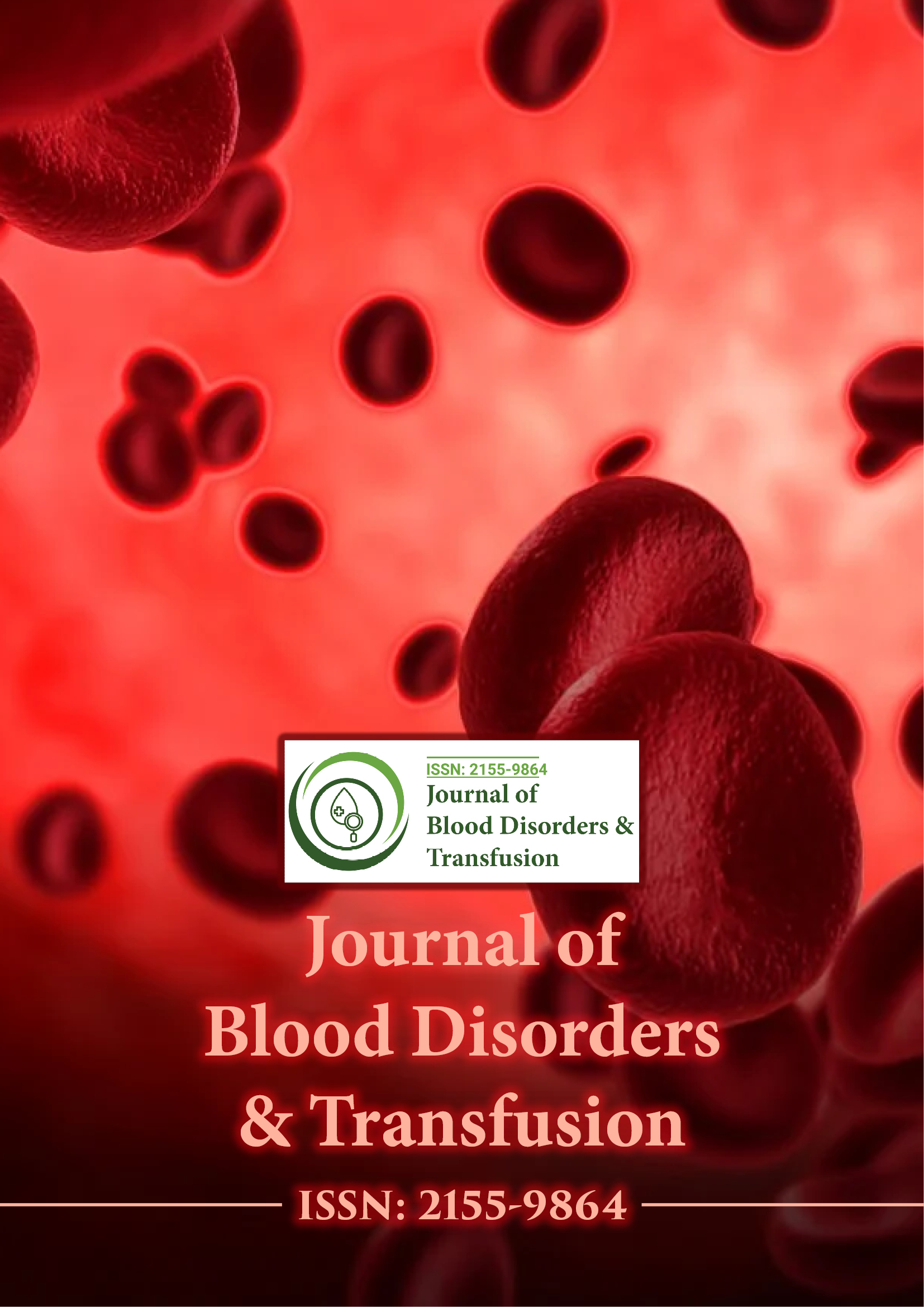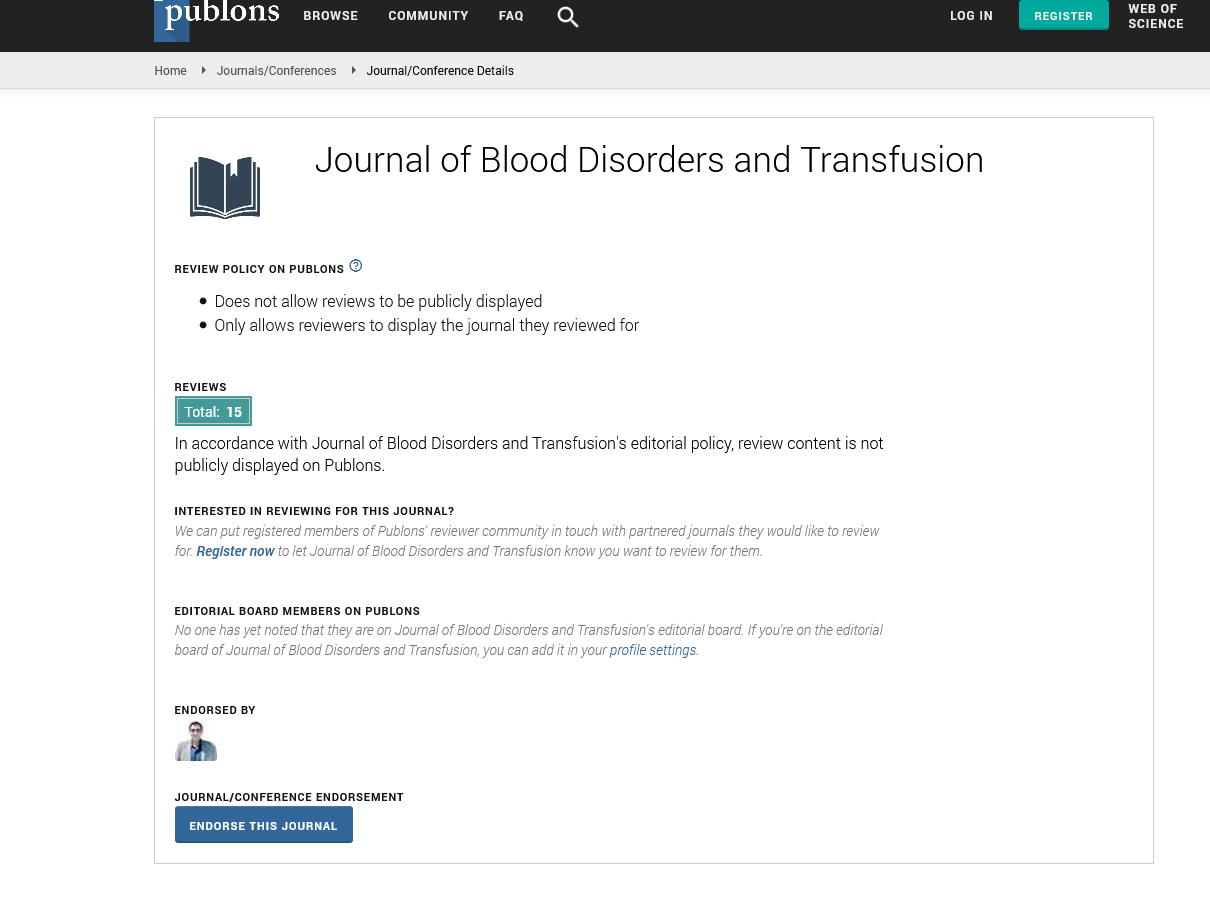Indexed In
- Open J Gate
- Genamics JournalSeek
- JournalTOCs
- Ulrich's Periodicals Directory
- RefSeek
- Hamdard University
- EBSCO A-Z
- OCLC- WorldCat
- Proquest Summons
- Publons
- Geneva Foundation for Medical Education and Research
- Euro Pub
- Google Scholar
Useful Links
Share This Page
Journal Flyer

Open Access Journals
- Agri and Aquaculture
- Biochemistry
- Bioinformatics & Systems Biology
- Business & Management
- Chemistry
- Clinical Sciences
- Engineering
- Food & Nutrition
- General Science
- Genetics & Molecular Biology
- Immunology & Microbiology
- Medical Sciences
- Neuroscience & Psychology
- Nursing & Health Care
- Pharmaceutical Sciences
Short Communication - (2024) Volume 0, Issue 0
Advancing Hematologic Malignancy Treatments: The Role of Stem CellDerived Red Blood Cells in Addressing Blood Shortages
Cha Marks*Received: 28-Oct-2024, Manuscript No. JBDT-24-27692; Editor assigned: 01-Nov-2024, Pre QC No. JBDT-24-27692 (PQ); Reviewed: 15-Nov-2024, QC No. JBDT-24-27692; Revised: 22-Nov-2024, Manuscript No. JBDT-24-27692 (R); Published: 29-Nov-2024, DOI: 10.4172/2155-9864.23.S11.054
Description
Blood shortages are a critical issue, especially for patients with hematologic malignancies such as leukaemia and lymphoma, who often require frequent transfusions. Traditional blood donation systems are not always able to meet the increasing demand for blood products. Stem cells have emerged as a promising alternative to address these shortages. The ability to generate Red Blood Cells (RBCs) from stem cells could revolutionize the treatment of these patients and offer a sustainable source of blood products. This paper explores the potential of stem cell-derived RBCs, the challenges in scaling up production and the impact of these advancements on hematologic malignancy treatments [1].
Stem cells, especially Hematopoietic Stem Cells (HSCs) and induced Pluripotent Stem Cells (iPSCs), hold great promise for RBC generation. Hematopoietic stem cells, which are found in the bone marrow, give rise to all blood cell types. Isolating and expanding these cells in vitro can lead to the generation of RBCs under controlled conditions with the addition of specific growth factors and cytokines. However, the process of scaling up production remains a challenge. HSCs can be expanded ex vivo, but ensuring a consistent and high yield of RBCs is difficult [2-5].
Induced pluripotent stem cells, which are reprogrammed somatic cells, offer another route for RBC generation. iPSCs can be induced to differentiate into erythroid progenitors, which can then mature into functional RBCs. This method is more versatile than using HSCs, as iPSCs can be derived from any somatic cell type, including those of the patient. Furthermore, the potential for creating patient-specific RBCs could minimize the risk of immune rejection in transfusion therapies. However, the process of reprogramming somatic cells into iPSCs and subsequently guiding them to differentiate into fully functional RBCs remains challenging.
Several challenges must be addressed to make stem cell-derived RBCs a viable solution for blood shortages in hematologic malignancies. Scalability is a primary issue. While it is feasible to generate RBCs in small quantities for research purposes, producing large quantities for clinical use is much more complex. Efficient scaling up of RBC production requires optimizing culture conditions, using bioreactor systems to support large-scale differentiation and ensuring consistency and quality of the final product. Additionally, while advances have been made in culturing erythroid cells, achieving full maturation of these cells remains an obstacle. RBCs must be capable of performing their primary function oxygen transport while also being durable enough to survive in the circulatory system. Incomplete or inefficient maturation may lead to the production of RBCs that are non-functional or short-lived [6-8].
Cost and time are also significant factors. The process of generating RBCs from stem cells is still expensive and time consuming, requiring precise control over each stage of differentiation. In addition, generating large numbers of cells requires considerable resources, making it difficult to scale production for widespread clinical use. The current limitations in cost and efficiency mean that stem cell-derived RBCs are not yet a practical solution for widespread transfusion therapies. Safety concerns also need to be addressed, particularly with iPSCs. While iPSCs hold promise for patient-specific RBCs, there is a risk that these cells may retain epigenetic signatures from their somatic origins, potentially leading to abnormal growth or oncogenic transformations. Extensive screening for genetic stability and rigorous safety protocols are necessary to ensure the safety of stem cell-derived RBCs before they can be used in patients [9,10].
Despite these challenges, recent advances in stem cell research have brought us closer to overcoming these barriers. Researchers have focused on optimizing the culture conditions necessary for erythropoiesis and new techniques in gene editing, such as CRISPR-Cas9, offer the potential to enhance the efficiency and yield of RBC generation. For instance, gene editing can be used to correct defects in erythropoiesis or to enhance specific pathways to improve RBC production. Additionally, 3D culture systems and bioreactor technologies have been developed to mimic the bone marrow environment more closely, improving the maturation of RBCs.
The potential clinical applications of stem cell-derived RBCs in hematologic malignancies are significant. Patients undergoing chemotherapy or radiation therapy often experience severe anemia due to the suppression of their bone marrow. In these cases, RBC transfusions are vital to managing anemia and improving patient outcomes. Stem cell-derived RBCs could offer a more sustainable and personalized source of blood for these patients. Moreover, patient-specific RBCs could reduce the risk of immune reactions associated with transfusions, providing a safer alternative to traditional blood products. Personalized medicine is an exciting prospect in this field. By deriving RBCs from a patient’s own iPSCs, it is possible to create a transfusion product that is genetically matched to the patient, minimizing the risk of rejection and other transfusion-related complications. This could be particularly beneficial for patients with hematologic malignancies who may require multiple transfusions throughout their treatment journey.
Looking forward, the future of stem cell-based RBC generation lies in overcoming the remaining technological and logistical challenges. There is a need for further research into optimizing the protocols for RBC production, improving gene editing techniques and enhancing the scalability of production systems. Once these hurdles are addressed, stem cell-derived RBCs could become a viable and sustainable alternative to traditional blood products, providing significant benefits for patients with hematologic malignancies. The generation of RBCs from stem cells represents a promising solution to the blood shortages that affect patients with hematologic malignancies. Although challenges remain in terms of scalability, maturation, cost and safety, recent advancements in stem cell biology and technology are paving the way for future clinical applications. As the field continues to evolve, stem cell-derived RBCs could become an essential component of personalized and sustainable therapies for hematologic malignancy patients.
References
- Haus E, Lakatua DJ, Swoyer J, Sackett‐Lundeen L. Chronobiology in hematology and immunology. American Journal of Anatomy. 1983;168(4):467-517.
[Crossref] [Google Scholar] [PubMed]
- Fonseca R, Blood E, Rue M, Harrington D, Oken MM. Clinical and biologic implications of recurrent genomic aberrations in myeloma. Blood. 2003;101(11):4569-4575.
[Crossref] [Google Scholar] [PubMed]
- Cristea IM, Gaskell SJ, Whetton AD. Proteomics techniques and their application to hematology. Blood. 2004;103(10):3624-3634.
[Crossref] [Google Scholar] [PubMed]
- Garraud O, Heshmati F, Pozzetto B, Lefrere F, Girot R. Plasma therapy against infectious pathogens, as of yesterday, today and tomorrow. Transfusion Clinique et Biologique. 2016 Feb 1;23(1):39-44.
[Crossref] [Google Scholar] [PubMed]
- Navada SC, Steinmann J, Lübbert M, Silverman LR. Clinical development of demethylating agents in hematology. J Clin Invest. 2014;124(1):40-46.
[Crossref] [Google Scholar] [PubMed]
- Witt DM, Nieuwlaat R, Clark NP, Ansell J, Holbrook A. American Society of Hematology 2018 guidelines for management of venous thromboembolism: optimal management of anticoagulation therapy. Blood Adv. 2018;2(22):3257-3291.
[Crossref] [Google Scholar] [PubMed]
- Rizzo JD, Lichtin AE, Woolf SH, Seidenfeld J, Bennett CL. Use of epoetin in patients with cancer: evidence-based clinical practice guidelines of the American Society of Clinical Oncology and the American Society of Hematology. Blood. 2002;100(7):2303-2320.
[Crossref] [Google Scholar] [PubMed]
- Roland L, Drillich M, Iwersen M. Hematology as a diagnostic tool in bovine medicine. Journal of Veterinary Diagnostic Investigation. 2014 Sep;26(5):592-598.
[Crossref] [Google Scholar] [PubMed]
- Dispenzieri A, Kyle RA, Lacy MQ, Rajkumar SV, Therneau TM. POEMS syndrome: definitions and long-term outcome: Presented in abstract form at the 41st annual meeting of the American Society of Hematology, New Orleans, LA, December 3-7, 1999. Blood. 2003;101(7):2496-2506.
[Crossref] [Google Scholar] [PubMed]
- George JW, Snipes J, Lane VM. Comparison of bovine hematology reference intervals from 1957 to 2006. Veterinary clinical pathology. 2010;39(2):138-148.
[Crossref] [Google Scholar] [PubMed]
Citation: Marks C (2024). Advancing Hematologic Malignancy Treatments: The Role of Stem Cell-Derived Red Blood Cells in Addressing Blood Shortages. J Blood Disord Transfus. S11.054.
Copyright: © 2024 Marks C. This is an open-access article distributed under the terms of the Creative Commons Attribution License, which permits unrestricted use, distribution, and reproduction in any medium, provided the original author and source are credited.

